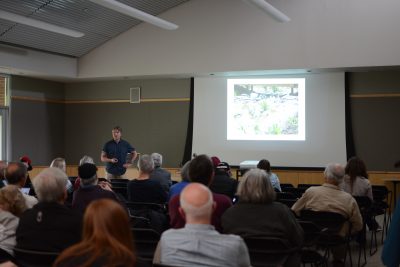On the surface, art and science might not seem to have much in common.
David Roon, instructor and program lead for Ecology and Conservative Biology, brought this up in his lecture “Leonardo’s Children: Creative Synergy at the Art-Conservation Interface” Sept. 19.
Roon said traditionally, the fine arts and the natural branch of science are often seen as twins in that both are considered easy “A” classes, but are otherwise considered unrelated to each other. Roon said now, opinion is adjusting and revealing that the two have much in common.

Connor McCaughan | Argonaut
Speaker David Roon lectures a group about art-conservation in the Idaho Commons the afternoon of Sept. 19.
Roon’s lecture derived its namesake from Renaissance man Leonardo Da Vinci, designer of some of the most well-known pieces of art today.
“Leonardo Da Vinci captivates me because he’s an influence of the art world,” Roon said. “He created very detailed diagrams and paintings about his work when science itself was seen more as an objective rather than art.”
At the beginning of his lecture, Roon handed out art pieces to the audience. After they had been distributed, he revealed the work as his own. Roon, who is primarily a sculptor, said art and science are closely linked. He also told the audience about the scientific explanations and inspirations behind each of his sculptures.
Roon said scientists and artists think similarly and both approach topics without fear of the unknown, rather embracing it. However, Roon said there is a slight difference between the two.
“It seems like in science we want to learn the stories, but an artist doesn’t always want to disclose stuff,” he said.
Roon said coming from a scientific background, he sometimes wants to be more obvious as an artist, but refrains. He referenced one of his new art pieces — a sculpture of a crocodile coming out of the floor surrounded by lily pads. He said he made the piece to represent contamination and pollution, but viewers created their own idea about what the sculpture meant. Roon said there were a variety of interpretations, but the most popular theory was that it centered on gender identity in society.
Throughout his lecture, Roon allowed the audience to ask questions about his experiences with instructing art from a scientific standpoint. The vast majority of those in attendance did ask questions, specifically about his experiences with students and their talents, how art has impacted him personally and what caused him to strive to get his art out there.
Roon ended his lecture by showing the audience water filtration devices he made out of clay along with coffee grounds. He said he is in the process of working on a piece to associate these to polluted waterways.
Cecil Milliken can be reached at arg-arts@uidaho.edu
